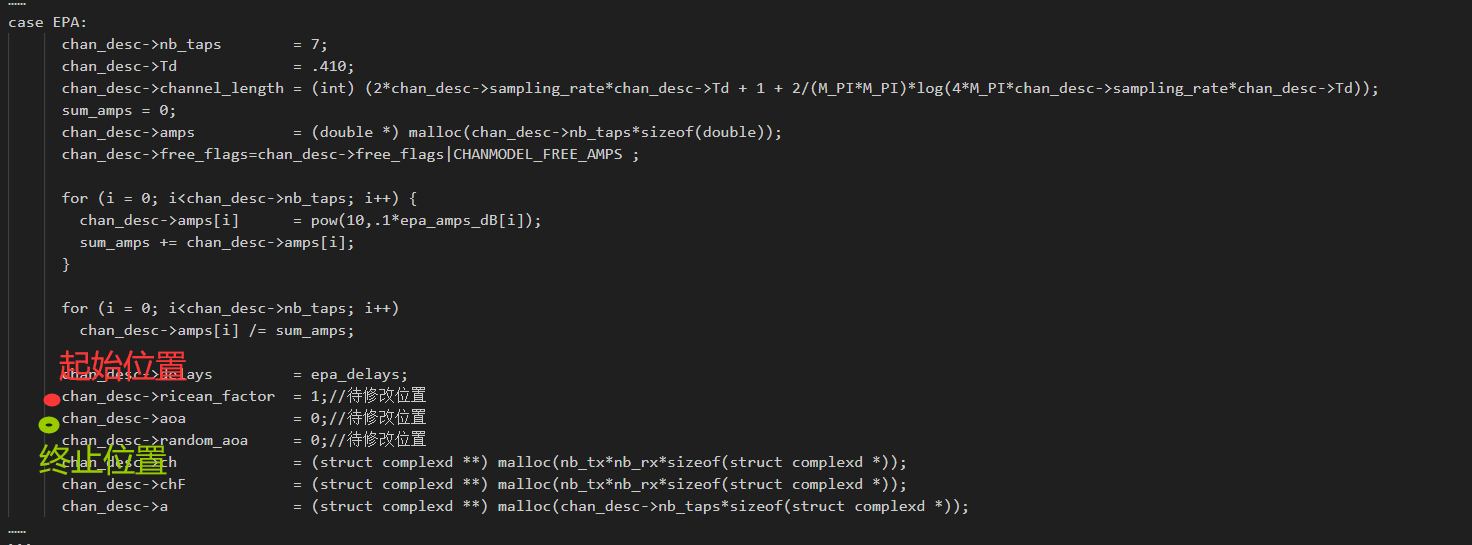1. 背景描述
最近在写一个后端项目,主要的操作就是根据用户的前端数据,在后端打开项目中的代码文件,修改对应位置的参数,因为在目前的后端项目中经常使用这个操作,所以简单总结一下。
1. 文件路径:./test.c
2. 文件内容
……
case EPA:
chan_desc->nb_taps = 7;
chan_desc->Td = .410;
chan_desc->channel_length = (int) (2*chan_desc->sampling_rate*chan_desc->Td + 1 + 2/(M_PI*M_PI)*log(4*M_PI*chan_desc->sampling_rate*chan_desc->Td));
sum_amps = 0;
chan_desc->amps = (double *) malloc(chan_desc->nb_taps*sizeof(double));
chan_desc->free_flags=chan_desc->free_flags|CHANMODEL_FREE_AMPS ;
for (i = 0; i<chan_desc->nb_taps; i++) {
chan_desc->amps[i] = pow(10,.1*epa_amps_dB[i]);
sum_amps += chan_desc->amps[i];
}
for (i = 0; i<chan_desc->nb_taps; i++)
chan_desc->amps[i] /= sum_amps;
chan_desc->delays = epa_delays;
chan_desc->ricean_factor = 1;//待修改位置
chan_desc->aoa = 0;//待修改位置
chan_desc->random_aoa = 0;//待修改位置
chan_desc->ch = (struct complexd **) malloc(nb_tx*nb_rx*sizeof(struct complexd *));
chan_desc->chF = (struct complexd **) malloc(nb_tx*nb_rx*sizeof(struct complexd *));
chan_desc->a = (struct complexd **) malloc(chan_desc->nb_taps*sizeof(struct complexd *));
……2. 单行修改-操作步骤
读取文件
使用python中的open()函数进行文件读取,将数据存储在缓冲区。#1. 读取文件 path='./test.c' with open(path, 'r') as file: file_content = file.read()查找文件替换位置
以查找chan_desc->ricean_factor = 1;//待修改位置为例,查找这句话的起点和终点。## 注:此步骤需要import re #2. 查找文件替换位置 start_index=file_content.find('chan_desc->ricean_factor = ')#起点 end_index=file_content.find('chan_desc->aoa = ',start_index)#终点 if end_index==-1 or start_index==-1: print('未找到待修改位置') #此时得到的两个指针,分别指向了待修改位置的起点和终点,如下图所示:设置替换文件内容
假设目前只修改这一行的参数,#3. 设置替换文件内容 ricean_factor=3#假设这是要修改的参数信息 updata_content=file_content[:start_index]#获取这行代码之前的内容 update_content+='chan_desc->ricean_factor = '+str(ricean_factor)+';//待修改位置'#修改这行代码 update_content+=file_content[end_index:]#获取这行代码之后的内容 #此时得到的update_content就是修改后的完整文件内容,只修改了ricean_factor这一行的值写入文件
同样使用python中的open函数。#4. 写入文件 if update_content!="":#如果修改内容不为空 with open(path, 'w') as file:#w表示覆盖写入,之前的内容都会被覆盖 file.write(update_content)总代码
整体的代码如下所示:import re #1. 读取文件 path='./test.c' with open(path, 'r') as file: file_content = file.read() #2. 查找文件替换位置 start_index=file_content.find('chan_desc->ricean_factor = ')#起点 end_index=file_content.find('chan_desc->aoa = ',start_index)#终点 if end_index==-1 or start_index==-1: print('未找到待修改位置') #3. 设置替换文件内容 ricean_factor=3#假设这是要修改的参数信息 updata_content=file_content[:start_index]#获取这行代码之前的内容 update_content+='chan_desc->ricean_factor = '+str(ricean_factor)+';//待修改位置'#修改这行代码 update_content+=file_content[end_index:]#获取这行代码之后的内容 #4. 写入文件 if update_content!="":#如果修改内容不为空 with open(path, 'w') as file:#w表示覆盖写入,之前的内容都会被覆盖 file.write(update_content)3. 多行修改-操作步骤
- 多行修改思路
多行修改有两种修改思路,如果修改部分比较集中,则可直接替换一整块的字符串内容,如果修改部分较为分散,则需要单独查找修改位置,然后再分别进行替换。 多行修改-整块替换
try: with open(file_path, "r") as file: file_content = file.read() except Exception as e: return str(e) # 设置改写内容 updated_content = "" # 查找修改 start_index_1 = file_content.find("start_sentence")#要确保查找元素的唯一性 end_index_1 = file_content.find("end_sentence",start_index_1,) if start_index_1 == -1 or end_index_1 == -1: print("未找到待修改位置") return -1 # updated_content = file_content[:start_index_1]#获取这行代码之前的内容 updated_content += "start_sentence和end_sentence之间的sentence_1;\n" updated_content += "start_sentence和end_sentence之间的sentence_2;\n" updated_content +=file_content[end_index_1:] ##此时updated_content就是修改后的完整文件内容 if updated_content != "": with open(file_path, "w") as file: file.write(updated_content) else: print("修改失败") return -1多行修改-局部替换
try: with open(file_path, "r") as file: file_content = file.read() except Exception as e: return str(e) # 设置改写内容 updated_content = "" # 查找修改 start_index_1 = file_content.find("start_sentence_1")#要确保查找元素的唯一性 end_index_1 = file_content.find("end_sentence_1",start_index_1,) start_index_2 = file_content.find("start_sentence_2",end_index_1) end_index_2 = file_content.find("end_sentence_2",start_index_2,) start_index_3 = file_content.find("start_sentence_3",end_index_2) end_index_3 = file_content.find("end_sentence_3",start_index_3,) start_index_4 = file_content.find("start_sentence_4",end_index_3) end_index_4 = file_content.find("end_sentence_4",start_index_4,) if ( start_index_1 == -1 or end_index_1 == -1 or start_index_2 == -1 or end_index_2 == -1 or start_index_3 == -1 or end_index_3 == -1 or start_index_4 == -1 or end_index_4 == -1 ): print("未找到待修改位置") return -1 # updated_content = file_content[:start_index_1]#获取这行代码之前的内容 updated_content += "start_sentence_1和end_sentence_1之间的内容" updated_content +=file_content[end_index_1:start_index_2] updated_content += "start_sentence_2和end_sentence_2之间的内容" updated_content +=file_content[end_index_2:start_index_3] updated_content += "start_sentence_3和end_sentence_3之间的内容" updated_content +=file_content[end_index_3:start_index_4] updated_content += "start_sentence_4和end_sentence_4之间的内容" updated_content += file_content[end_index_4:] ##此时updated_content就是修改后的完整文件内容 if updated_content != "": with open(file_path, "w") as file: file.write(updated_content) else: print("修改失败") return -1


**粗体** _斜体_ [链接](http://example.com) `代码` - 列表 > 引用。你还可以使用@来通知其他用户。